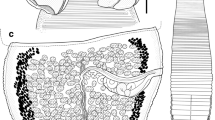Abstract
The sampling of 22 specimens of Rhizoprionodon oligolinx Springer from the Persian Gulf made possible the description of three new species of Anthobothrium van Beneden, 1850. Anthobothrium parimae sp. nov. is different from its congeners, except for A. altavelae Neifar, Euzet and Ben Hassine, 2002, A. lyndoni Ruhnke and Caira, 2009, and A. lesteri Williams, Burt and Caira, 2004, in the total length. It differs from A. altavelae in the number of the proglottids; from A. lyndoni in the length of the mature proglottids; and from A. lesteri Williams, Burt and Caira, 2004 in possessing one hemicircular band, rather than two circular bands, of musculature in its bothridia. The other two new species, being the smallest in size within the genus, most closely resemble each other but differ in the position of the genital pore in the proglottid, the number of post-vaginal testes, the number of the ventral and dorsal columns of vitelline follicles in each lateral band, and the distribution of the gladiate spinitriches on the strobila. These three new species are the only “tetraphyllidean” species reported to date from the southern waters of Iran. In addition, for the first time, more than two congeners belonging to Anthobothrium are reported from the same host species sympatrically and simultaneously. The morphological variation within this genus is also discussed.






Similar content being viewed by others
Data availability
All data generated or analyzed during this study are included in this published article. For the raw data, please contact the corresponding author.
References
Caira JN, Jensen K, Ruhnke TR (2017) “Tetraphyllidea” van Beneden, 1850 relics. In: Caira JN, Jensen K (eds) Planetary biodiversity inventory (2008–2017): tapeworms from vertebrate bowels of the earth. University of Kansas, Natural History Museum, Special Publication No. 25, Lawrence, KS, USA, pp 371–400
Caira JN, Jensen K, Waeschenbach A, Olson PD, Littlewood DTJ (2014) Orders out of chaos—molecular phylogenetics reveals the complexity of shark and stingray tapeworm relationships. Int J Parasitol 44:55–73. https://doi.org/10.1016/j.ijpara.2013.10.004
Chervy L (2009) Unified terminology for cestode microtriches: a proposal from the international workshops on Cestode systematics in 2002–2008. Folia Parasit 56:199–230. https://doi.org/10.14411/fp.2009.025
Henderson AC, Reeve AJ, Jabado RW, Naylor GJ (2016) Taxonomic assessment of sharks, rays and guitarfishes (Chondrichthyes: Elasmobranchii) from south-eastern Arabia, using the NADH dehydrogenase subunit 2 (NADH2) gene. Zool J Linn Soc-Lond 176:399–442. https://doi.org/10.1111/zoj.12309
Jabado RW, Al Ghais SM, Hamza W, Shivji MS, Henderson AC (2015) Shark diversity in the Arabian/Persian Gulf higher than previously thought: insights based on species composition of shark landings in the United Arab Emirates. Mar Biodivers 45:719–731. https://doi.org/10.1007/s12526-014-0275-7
Jabado RW, Ebert DA (2015) Sharks of the Arabian seas: an identification guide. The International Fund for Animal Welfare, Dubai, UAE
Jensen K, Bullard SA (2010) Characterization of a diversity of tetraphyllidean and rhinebothriidean cestode larval types, with comments on host associations and life-cycles. Int J Parasitol 40:889–910. https://doi.org/10.1016/j.ijpara.2009.11.015
Neifar L, Euzet L, Ben Hassine OK (2002) Anthobothrium altavelae sp. n. (Cestoda: Tetraphyllidea) from the spiny butterfly ray Gymnura altavela (Elasmobranchii: Gymnuridae) in Tunisia. Folia Parasit 49:295–298. https://doi.org/10.14411/fp.2002.054
Olson PD, Caira JN (1999) Evolution of the major lineages of tapeworms (Platyhelminthes: Cestoidea) inferred from 18S ribosomal DNA and elongation factor-1α. J Parasitol 85:1134–1159. https://doi.org/10.2307/3285679
Ruhnke TR, Caira JN (2009) Two new species of Anthobothrium van Beneden, 1850 (Tetraphyllidea: Phyllobothriidae) from carcharhinid sharks, with a redescription of Anthobothrium laciniatum Linton, 1890. Syst Parasitol 72:217–227. https://doi.org/10.1007/s11230-008-9168-0
Subhapradha CK (1955) Cestode parasites of fishes of Madras Coast. Indian J Helminthol 7(2):41–132
Suriano DM (2002) Anthobothrium galeorhini sp. nov. (Eucestoda: Tetraphyllidea) a parasite of Galeorhinus galeus (Triakidae) from the Argentine coast. Parasite 9:121–125. https://doi.org/10.1051/parasite/2002092121
van Beneden P-J (1850) Recherches sur la faune littorale de Belgique. Les vers cestoides, considérés sous le rapport physiologique, embryogénique et zooclassique. Mémoires de l‘Academie Royale des Sciences, des Lettres et des Beaux-Arts de Belgique 25: 1–199
Williams HH, Burt MDB, Caira JN (2004) Anthobothrium lesteri sp. nov. (Cestoda: Tetraphyllidea) in Carcharhinus melanopterus from Heron Island, Australia, with comments on its site, mode of attachment, reproductive strategy and membership of the genus. Syst Parasitol 59:211–221. https://doi.org/10.1023/B:SYPA.0000048100.77351.9f
Acknowledgements
Thanks are due to the Iranian Fisheries Science Research Institute, which allowed us to examine the sharks sampled under its project of stock assessment.
Funding
The research affairs of the University of Guilan financially supported this work.
Author information
Authors and Affiliations
Contributions
MH conceived, designed, and supervised the research. MSK measured and drew. MH wrote the manuscript. All authors read and approved the manuscript. This article is based on the student (MSK)’s MSc thesis.
Corresponding author
Ethics declarations
Ethics approval
All applicable international, national, and/or institutional guidelines for animal testing, animal care, and use of animals were followed by the authors.
Sampling and field studies
All necessary permits for sampling and observational field studies have been obtained by the authors from the competent authorities, the Iranian Fisheries Science Research Institute, and are mentioned in the acknowledgements. The study is compliant with CBD (Convention on Biological Diversity) and Nagoya protocols.
Conflict of interest
The authors declare no competing interests.
Additional information
Section Editor: Matthew Thomas Wayland
Publisher's note
Springer Nature remains neutral with regard to jurisdictional claims in published maps and institutional affiliations.
This article was registered in the Official Register of Zoological Nomenclature (ZooBank) as urn:lsid:zoobank.org:pub:18D2BFF9-3F86-4213-95B1-C3411A9A37F7
Rights and permissions
About this article
Cite this article
Sadeghi Kamachali, M., Haseli, M. Three new species of Anthobothrium van Beneden, 1850 (Cestoda: “Tetraphyllidea”) from the grey sharpnose shark Rhizoprionodon oligolinx Springer, 1964 (Carcharhinidae) in the Persian Gulf. Parasitol Res 121, 143–154 (2022). https://doi.org/10.1007/s00436-021-07397-0
Received:
Accepted:
Published:
Issue Date:
DOI: https://doi.org/10.1007/s00436-021-07397-0




